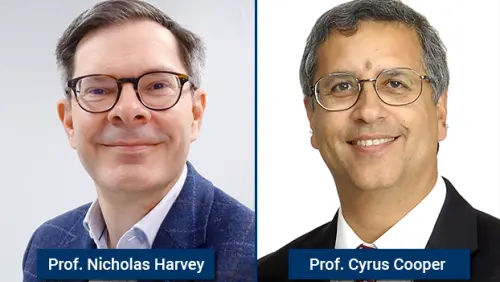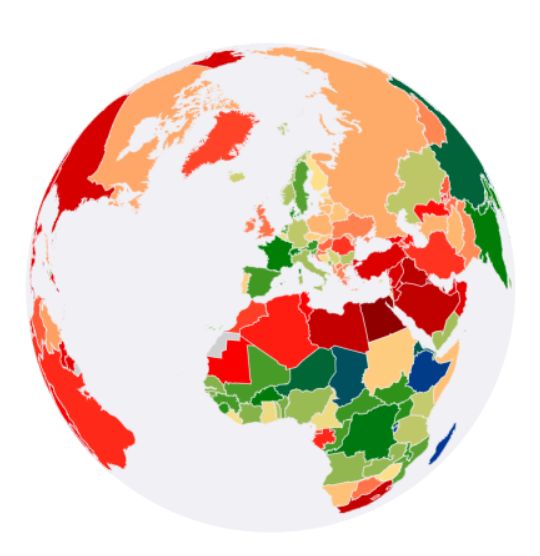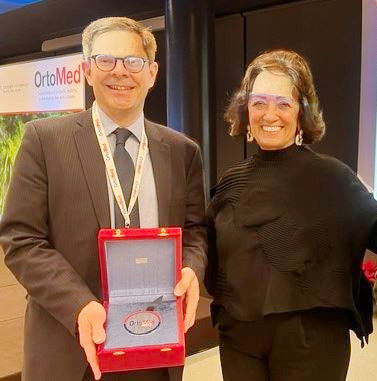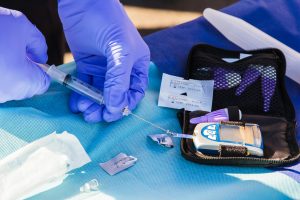[vc_row][vc_column][vc_column_text]Southampton researchers have contributed to the trial of a community-based screening programme in older UK women, demonstrating an estimated 28% reduction in hip fractures. [/vc_column_text][vc_column_text]Results of a large multicentre UK-based study published today in The Lancet demonstrate that screening of older women for fracture risk, and recommending treatment accordingly, leads to a marked reduction in the risk of new hip fractures. The approach was based on a simple questionnaire, combined with bone mineral density measurements in some patients, with fracture risk (percent chance of experiencing a fracture over the next 10 years) calculated using the online “FRAX” tool. Licenced osteoporosis treatments were targeted through local GP practices to women found to be at high risk of fracture; the screening intervention resulted in a 28% reduction in hip fractures over 5 years.[/vc_column_text][vc_column_text]The randomised controlled ‘SCreening for Osteoporosis in Older women for the Prevention of fracture’ study (SCOOP) was funded by the Medical Research Council and Arthritis Research UK and involved 12 483 eligible women aged 70-85 years, identified from primary care. The study was a major national collaboration between the Universities of Sheffield, East Anglia, Southampton, Bristol, Birmingham, Manchester and York.[/vc_column_text][vc_column_text el_class=”reflist”]Findings included:Findings included:
- Of 6233 women randomised to screening, treatment was recommended in 898 (14.4%).
- Osteoporosis medication use was higher at the end of year one in the screening group compared with controls (15·3% vs 4·5%), with uptake particularly high (78.3% at 6 months) in the screened high risk subgroup.
- While screening did not reduce the incidence of all osteoporosis-related fractures (hazard ratio: 0·94, p=0·178, 95% C.I.: 0·85 to 1·03), there was strong evidence for a 28% reduction in hip fractures (hazard ratio: 0·72, p=0·002 95% C.I.: 0·59 to 0·89).
- There was no evidence that the screening programme had impacts on anxiety levels, quality of life or mortality.
[/vc_column_text][/vc_column][/vc_row][vc_row top_margin=”page_margin_top_section”][vc_column width=”1/4″][vc_column_text]Professor Nicholas Harvey, Professor of Rheumatology and Clinical Epidemiology at the MRC Lifecourse Epidemiology Unit, University of Southampton, and a co-author of the study, said:[/vc_column_text][/vc_column][vc_column width=”3/4″][vc_column_text]
“This is the first trial to show that a community-screening approach based upon the FRAX fracture risk tool is feasible, and importantly, effective at reducing the risk of these devastating fractures. We estimate that if the strategy could be implemented exactly as in the SCOOP study, it could prevent up to 8000 hip fractures per year.”
[/vc_column_text][/vc_column][/vc_row][vc_row top_margin=”page_margin_top_section”][vc_column width=”2/3″][vc_column_text]
“This trial, which informs a potential major alteration to national policies aimed at the prevention of osteoporotic fractures, demonstrates the critical importance of such institutional collaboration across the UK in addressing fundamental public health problems. It is only with investment in such investigational approaches, and their subsequent adoption into policy, that we can optimally address the immense public health burden caused by osteoporosis and related fractures.”
[/vc_column_text][/vc_column][vc_column width=”1/3″][vc_column_text]Professor Cyrus Cooper, Professor of Rheumatology and Director, MRC Lifecourse Epidemiology Unit, University of Southampton, and a co-author of the study, commented:[/vc_column_text][/vc_column][/vc_row][vc_row top_margin=”page_margin_top_section”][vc_column][vc_column_text]Reference:[/vc_column_text][vc_column_text]Shepstone L, Lenaghan E, Cooper C, Clarke S, Fong R, Fordham R, Gittoes N, Harvey I, Harvey N, Heawood A, Holland R, Howe A, Kanis J, Marshall T, O’Neill T, Peters T, Redmond N, Torgerson D, Turner D, McCloskey E & the SCOOP Study Team. A Randomized Controlled Trial of Screening in the Community to Reduce Fractures in Older Women: The SCOOP Study. http://www.scoopstudy.ac.uk[/vc_column_text][vc_column_text]About osteoporosis[/vc_column_text][vc_column_text]Around the world, approximately one in three women and one in five men aged 50 years or more will suffer a fragility fracture during their remaining lifetime. In the UK alone around 536 000 people suffer fragility fractures each year, including 79 000 hip fractures. For the individual, a hip fracture can be devastating, with loss of independence and less than one third of patients making a full recovery; mortality at one-year post-fracture is approximately 20%. Effective identification and management of individuals at risk of costly hip fractures should therefore be an important healthcare priority. Hip fractures are an enormous cost to the healthcare system, with total annual hospital costs of new hip fractures in the UK estimated to be around £1.1 billion.[/vc_column_text][vc_column_text]About FRAX[/vc_column_text][vc_column_text]FRAX® is a simple calculation tool that integrates clinical information in a quantitative manner to predict a 10-year probability of major osteoporotic fracture for both women and men in different countries. The tool, launched by the then WHO Collaborating Centre for Metabolic Bone Diseases in 2008, was developed at the Centre for Metabolic Bone Diseases, University of Sheffield, UK in collaboration with international researchers. It assists primary health-care providers to better target people in need of interventions to reduce fracture risk, thus improving the allocation of health-care resources towards patients most likely to benefit from treatment. The FRAX calculator is now available for 63 countries and in 34 languages. https://www.sheffield.ac.uk/FRAX/[/vc_column_text][vc_column_text]About IOF[/vc_column_text][vc_column_text]The International Osteoporosis Foundation (IOF) is the world’s largest nongovernmental organization dedicated to the prevention, diagnosis and treatment of osteoporosis and related musculoskeletal diseases. IOF members, including committees of scientific researchers as well as 240 patient, medical and research societies in 99 locations, work together to make fracture prevention and healthy mobility a worldwide heath care priority. http://www.iofbonehealth.org / http://www.facebook.com/iofbonehealth / @iofbonehealth[/vc_column_text][/vc_column][/vc_row]








